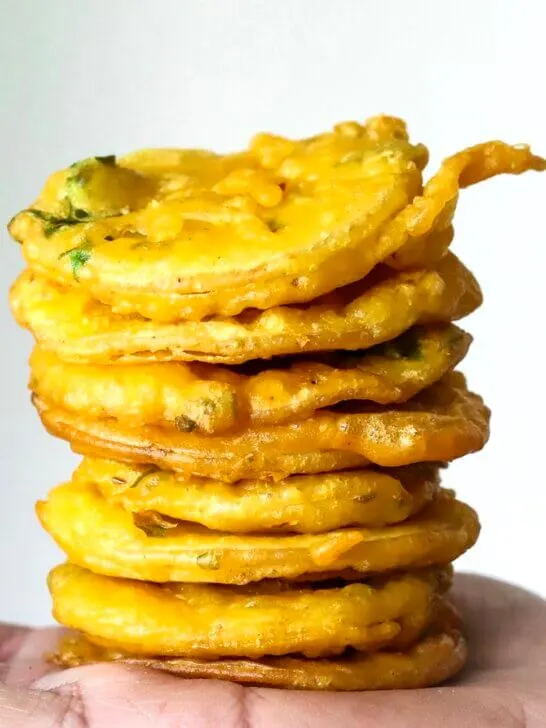Forged from the coming together of two distinct cuisines, Crispy Potato Bhajias have earned their place as a treasured dish on the South Asian-East African dinner table.
No dish is an island
For me, “fusion” is not a dirty word when it comes to food. Often characterised as a slap-dash stab at innovation, the concept of “fusion” is all too frequently misunderstood in today’s food narrative.
As a British child of Kenyan and Tanzanian immigrants, both with Indian Gujarati ancestry, the concept of “fusion food” was deep-rooted in the meals I grew up with.
Over years, a mishmash of culinary principles became a cherished by-product of the complex history of South Asian settlers in East Africa.
This seemingly organic partnership is testament to the notion that food and food culture is permeable, shape-shifting and travels with us, regardless of man-made geographical borders.

We are what we eat
A pinch of Indian masala added to African staples like cassava, matoke, beans and maize is the comfort food my grandfather taught my father to cook.
While my Gujarati ancestors would have historically, never had access to many of the core ingredients we use today, these treasured dishes evolved with us and have ultimately carved a place in our cooking arsenal.
What we eat is as culturally diverse as we are.
Here’s my dad’s recipe for Crispy Potato Bhajia. They’re famous in our family.



What are crispy potato bhajias?
In short, bhajias are vegetables coated in a batter of gram flour and spices before being fried until crispy. They can be made with almost any vegetable. But potatoes are so lovely, aren’t they?
I’ve eaten hundreds in my time and I have to say, nothing outshines potato bhajias done well. They need to be super crispy on the outside, fluffy in the middle, light and absolutely not greasy.
What spices are used to make bhajia?
That really depends on your taste. The batter is a blank canvas. You can assume that most recipes include: chilli, ajwain, garlic and turmeric.
Restaurants and street vendors all have their own unique recipes and will probably never share their secrets with anyone.
Don’t worry though, I pestered my dad long enough to get him to show me how he makes his famous bhajia. No need to thank me.
The garlic
IMPORTANT! Use dried garlic powder in your bhajia. Once fried, dried garlic powder gives your bhajias incredible depth of flavour that fresh garlic cannot match.
How thinly should I slice the potatoes?
As thin as you can get them, without them being see-through! We’re not looking for paper thin slices here. 4-5mm is ideal. Use a sharp knife and slice them by hand, or use a mandoline to make light work of it
Once sliced, dunk your potato slices in a bowl of ice water to keep them from turning brown (and to remove excess starch).
How far in advance can I make crispy potato bhajia?
Fry them immediately before serving. They don’t wait around for anyone. Potato bhajias need to be eaten hot.
The magic is in the crispy batter and steamy potato middle. If you want to prep some of the recipe, make the batter a day ahead and keep it refrigerated.
You can also slice the potatoes a couple of hours ahead of time — just be sure to keep them in a bowl of ice water.
Are these crispy potato bhajias vegan?
Yes!
Are they gluten free?
My dad’s recipe isn’t gluten free but you can switch the plain flour in his recipe for any gluten-free flour blend and ensure your baking powder is a GF one. I’ve done this with great results!
Can I use the batter recipe to make other types of bhajia?
Absolutely! Experiment away. If potatoes aren’t your jam, try dipping any of the following in this batter to create the bhajias you love:
- Cauliflower
- Mushrooms
- Okra
- Raw banana (seriously amazing!)
- Onion rings
- Asparagus
- Spinach leaves (so crispy and delicious)
- Babycorn
- Karela (bitter melon)
- Pretty much anything else that can be battered and fried
How to serve crispy potato bhajias
With chai, always with chai. Proper kadak masala chai (strong, sweet tea with milk and lots of cardamom is my favourite).
They’re always popular when the weather is bad and all you want to do is cosy up indoors with a plate of belly-warming comfort food.
Wait, what about the chutney?
Don’t worry, I’ve got your back. I’ve included my dad’s signature hot and sour cucumber chutney (served cold) in the recipe below. It’s fresh, zingy and an utterly delicious contrast to the steaming hot bhajia.
Other types of chutney to serve with Bhajias
How to make Crispy Potato Bhajias

Ingredients
- 1kg potatoes thinly sliced (I used a mandoline)
Ingredients for the batter:
- 450 g chickpea flour
- 100 g plain flour
- 1/4 tsp baking powder
- 1/2 tsp citric acid
- 1 tsp garlic powder
- 1 tsp onion powder
- 1/2 tsp ground ginger powder
- 1/2 tsp ground turmeric
- 1/2 tsp chilli powder
- 1/2 tsp ajwain seeds
- 1 1/2 tsp fine salt
- 2 tbsp sunflower or rapeseed oil
- 625 ml warm water
- 2 tbsp fresh coriander chopped
- 5 fresh ajwain leaves chopped (optional)
- 1 green chilli minced (optional)
- 1 L sunflower or rapeseed oil for deep frying
For the chutney:
- 200 g cucumber roughly chopped
- 200 g ripe tomatoes roughly chopped
- 140 g peeled carrots roughly chopped
- 1 large clove garlic
- 50 g fresh coriander leaves and stalks
- 4 hot green chillies
- Juice of 2 lemons
- 150 ml water
- 1 tbsp sugar
- 2 tsp salt
Instructions
- Immerse the sliced potatoes in a large bowl filled with ice cold water. Set aside.
To make the batter:
- Place all the ingredients for the batter in a large mixing bowl except the water and mix all the ingredients together.
- Add the water, a little at a time to form a thin, crêpe-style batter, just thick enough to coat the potato slices.
- Rest the batter at room temperature for 30 minutes.
- Heat oil to 190°C/375°F in a large, deep pan.
- Dry a handful of potato slices in a clean tea towel. Ensure each slice is free from any water.
- Dip each slice in the batter and carefully slide into the hot oil. Fry until golden and cooked through, about 3-4 minutes. Try not to overcrowd the pan and work in small batches.
- Drain the bhajias on a plate lined with kitchen towel.
To make the chutney:
- Blend all the ingredients until coarsely pureed. You want it to be a little chunky.
- Keep the chutney in the fridge until you're ready to serve. This chutney is best served cold.
Pin it for later!

If you like this, you’ll love these Homemade Pea & Potato Samosas
Love Sanjana



indra
Friday 16th of February 2024
Similar to Maru Bhajia, love to make it. There is a very distinct aloo bhel that was made by a Panwalla shop in Nairobi that was next door to Maru Bhajia, Cross Road, Nairobi. love to know if you or your family may know how to make it. Many thanks, looking forward to your book.
Delicious Vegetarian Street Food Recipes to Satisfy Your Cravings
Friday 3rd of February 2023
[…] 10. Bhajias […]
Raksha
Wednesday 14th of December 2022
Born and raised in Kampala Uganda. Brings back memories of Kenyan Chevdo!! Yummy!!
R Hirani
Saturday 27th of February 2021
Born n raised in Kenya these bring back loads of lovely memories. Asante sana rafiki:)
Luisa Lomavatu
Tuesday 1st of December 2020
Really awesome yummy